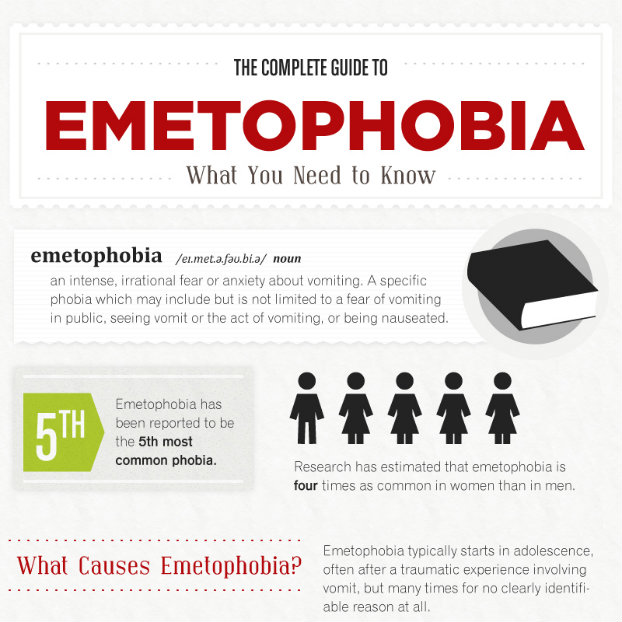 Emily Dickinson may be nestled inside you. Or maybe you have a Dean Koontz, Stephen King or Edgar Allen Poe screaming to get out. Even if horror or poetry is not your style, you may still have a writer with loads of writing buried inside.
Emily Dickinson may be nestled inside you. Or maybe you have a Dean Koontz, Stephen King or Edgar Allen Poe screaming to get out. Even if horror or poetry is not your style, you may still have a writer with loads of writing buried inside.
There’s only one problem. When you sit down to write, your head just won’t shut up. It yells. It bombards. It sends thoughts to distract you. It reminds you to clean your closet or shut off the iron or otherwise run around do anything other than write.
Clearing your head can be a tricky task, whether you want it cleared out for writing, meditating or even getting a good night’s sleep. Tricky as it is, it can be done.
Just as there’s no single method that automatically works wonders to alleviate everyone’s emetophobia or general anxiety, there’s no single head-clearing strategy that works for every writer.
There are, however, several methods you can try, thanks to the ideas we’ve culled from other writers, bloggers and our own experience.
Set the Stage
Even if some of your best ideas come to you at a crowded party or on the clacking subway train, you may be better off in general if you create a calm, distraction-free environment before you even take your pen to the page. That means putting the piles of unopened mail out of your sight, turning off your cell phone and not checking your email or Facebook page every two seconds.
Take it one step further by setting up a special writing place where you have adequate lighting, a comfy chair and something inspiring to look at. Inspiration can come from something as simple as an open window – provided you’re not distracted into cleaning it if you notice lots of dirt.
Reading something inspiring can also be a great tool, according to the QuietlyFabulous blog. Grab a book by your favorite author or a tome of inspirational quotes.
Writing coach Ali Luke notes another potentially helpful way to get the ball rolling is to spend several minutes warming up your writing muscles. Luke suggests taking 10 minutes of freestyle-type writing as a kind of initiation into the writing process. Use a writing prompt or pick a random word out of the dictionary and just go for it.
Freestyle writing also lets you explore your thoughts and ideas, learning more about what you may really want to say when you sit down to write. The warm-up also serves to get your thoughts flowing, your pen moving and your brain juiced up for more words and ideas to come.
Even if you don’t write in complete sentences or use a prompt, jotting down all your thoughts regarding what you plan to write about can help, Luke adds. Rather than sitting down in a frenzied panic and trying to capture all the thoughts before they leave your head, getting them down on paper lets you move through them methodically and artistically.
Create a Ritual
Creating a ritual that puts you in a writing frame of mind can also help clear your head. We explore the power of a morning ritual in part five of our series on Fixing Your Anxiety Potholes, and a writing ritual can have equally potent effects.
Maybe you want to try a bit of meditation, take a series of deep breaths, take a pre-writing walk or listen to soothing, energizing or uplifting music. Establishing a ritual can serve a three-part function:
- Clearing your mind
- Freeing up your thoughts
- Giving your brain the cue that it’s time to sit down and write
When All Else Fails, Surrender!
Surrendering is an awesome tool for annoying thoughts because it catches them off guard. Many of us try to push annoying thoughts out of our heads, which only makes them clamor more loudly. When you instead give them your full attention, you may be surprised to find they cower in confusion and even fear.
Here’s how the scenario can go:
- An annoying thought lingers on the sides of your brain
- Instead of pushing it away, you shine the spotlight on it, asking it what it wants and why it’s taking up your time
- The thought scampers away into never-neverland as all it wanted to do was distract you and is wholly embarrassed that it failed
Another way to give your distracting thoughts center stage is to put them down on paper. We particularly like how IT pro and blogger Mark Dykeman puts it:
Write madly to get some mental breathing room.
Once again, instead of trying to mentally push the thoughts from your brain, give them all your attention by writing them down or drawing a picture of what’s swirling around in your head.
Not only does this catch the thoughts off-guard, but you may find they lead to other thoughts, new ideas and even golden nuggets that can add to your writing rather than detract from it.
If you find the written-down or drawn-out jumble of thoughts don’t lend themselves to further exploration or ideas, you can always rip up, shred or burn the paper in a kind of ceremony that sends them off into oblivion.
One final tip is to kick excuses to the curb. Your closet does not need cleaning, the window does not need washing and the dog does not need walking – at least not at that exact moment. Nor should you listen to the fear-based excuses that may tell you that your writing will never be good enough, you’ll never get your novel published or that your poems will never match those of Emily Dickinson.
In all honesty, the only way you can fail at writing is to fail to pick up that pen and just write!
SOURCES:





